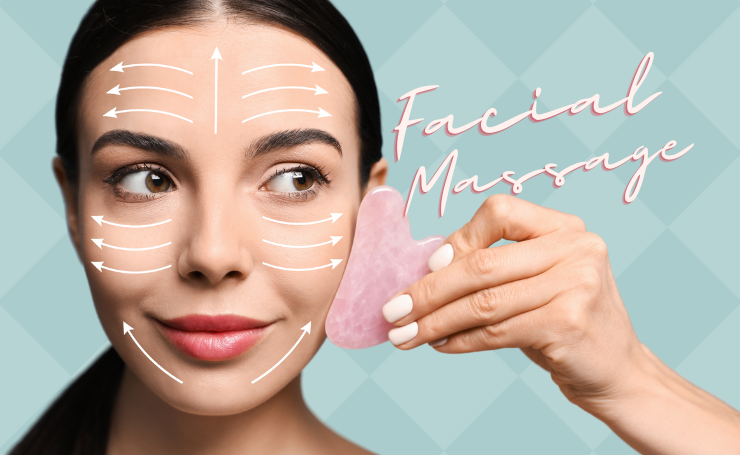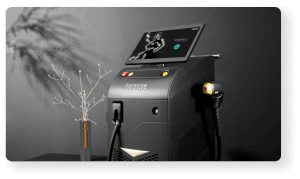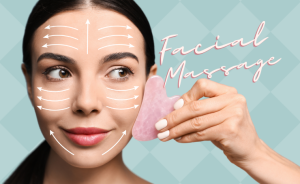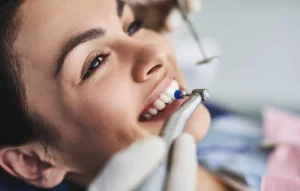Facial massage offers several potential benefits for the skin and overall well-being. Here are some of the advantages of incorporating facial massage into your skincare routine:
- Increased blood circulation: Facial massage stimulates blood flow to the skin, which can improve the delivery of oxygen and nutrients to the cells. Enhanced circulation can result in a healthier complexion and a natural glow.
- Lymphatic drainage: Facial massage techniques, such as gentle strokes and lymphatic drainage movements, can help to promote lymphatic fluid circulation. This can reduce puffiness, decrease fluid retention, and enhance the removal of toxins and waste products from the skin.
- Relaxation and stress reduction: Facial massage can be incredibly relaxing and help alleviate stress. The gentle touch and rhythmic movements of the massage can induce a sense of calmness, relieve muscle tension, and promote overall relaxation.
- Improved muscle tone: Regular facial massage can help tone and strengthen the facial muscles. By targeting specific muscles, it may contribute to firmer, more lifted facial contours and reduce the appearance of sagging or drooping skin.
- Enhanced product absorption: Massaging the skin with gentle, upward strokes can improve the absorption of skincare products. The massage helps to distribute the products evenly, allowing the active ingredients to penetrate deeper into the skin and potentially maximize their effectiveness.
- Reduced facial tension and wrinkles: Facial massage techniques can help release tension in the facial muscles, which may contribute to a more relaxed and smoother appearance. It can also help soften the appearance of fine lines and wrinkles by promoting circulation and stimulating collagen production.
- Overall rejuvenation: Regular facial massage can contribute to a revitalized and refreshed appearance. It can help improve skin texture, promote a healthy glow, and leave the skin looking more radiant and youthful.
It’s important to note that while facial massage can offer various benefits, it is essential to use gentle pressure and suitable techniques to avoid causing any damage or irritation to the skin. If you have specific skincare concerns or conditions, it’s advisable to consult with a licensed esthetician or skincare professional who can provide personalized guidance and recommendations.
If you’re considering a professional approach, a customized session like a Facial treatment Dubai often includes targeted facial massage techniques to maximize both relaxation and skin benefits.

Increased blood circulation
Increased blood circulation is one of the benefits associated with facial massage. When you massage your face, the pressure and movement stimulate blood flow to the skin. Here are some ways increased blood circulation can be beneficial:
- Improved skin health: Increased blood flow brings more oxygen and nutrients to the skin cells, promoting their health and vitality. It can help nourish the skin, enhance its natural functions, and support a healthy complexion.
- Enhanced skin tone and texture: Adequate blood circulation can contribute to a more even skin tone and a smoother texture. It may help reduce dullness, promote a vibrant glow, and improve the overall appearance of the skin.
- Effective toxin removal: Improved circulation supports the elimination of toxins and waste products from the skin cells. This can assist in detoxification processes and contribute to a clearer complexion.
- Faster healing and tissue repair: When blood flow to the skin is increased, it can expedite the healing process and facilitate tissue repair. This can be beneficial for reducing the appearance of scars, promoting the fading of blemishes, and aiding in the recovery of damaged skin.
- Plumping and firming effect: Enhanced blood circulation can give a temporary plumping effect to the skin, making it appear more plump and youthful. It can also support collagen production and contribute to improved skin elasticity and firmness over time.
- Reduced puffiness and fluid retention: Poor blood circulation can contribute to fluid retention and puffiness in the face. By promoting blood flow, facial massage can help reduce swelling, drain excess fluid, and alleviate puffiness, resulting in a more sculpted and contoured appearance.
It’s important to note that while facial massage can help increase blood circulation, it may not provide dramatic or long-lasting effects on its own. It is often most effective when combined with a comprehensive skincare routine that includes proper cleansing, moisturizing, sun protection, and other targeted treatments based on individual skin concerns.

Lymphatic drainage
Lymphatic drainage refers to a technique that aims to stimulate the lymphatic system and promote the flow of lymph fluid throughout the body. The lymphatic system is a network of vessels and lymph nodes that play a crucial role in immune function and waste removal from tissues.
In the context of facial massage, lymphatic drainage techniques are used to encourage lymph flow in the face and neck area. Here are some benefits associated with facial lymphatic drainage:
- Reduced facial puffiness: Lymphatic drainage massage can help reduce fluid retention and alleviate puffiness in the face. By promoting lymphatic circulation, it aids in the removal of excess fluid and toxins, resulting in a more sculpted and toned appearance.
- Detoxification: The lymphatic system acts as a filtration system, removing waste products, toxins, and cellular debris from tissues. By stimulating lymphatic flow, facial lymphatic drainage can enhance the detoxification process and support a healthier complexion.
- Improved skin tone and radiance: By facilitating the removal of waste products and promoting circulation, lymphatic drainage can contribute to a brighter and more radiant complexion. It can help even out skin tone, reduce dullness, and enhance the overall glow of the skin.
- Enhanced absorption of skincare products: Proper lymphatic drainage can help improve the absorption of skincare products. By clearing the lymphatic pathways, it allows for better delivery of nutrients and active ingredients to the skin cells, maximizing the effectiveness of your skincare routine.
- Relaxation and stress relief: Like other massage techniques, facial lymphatic drainage can induce a sense of relaxation and relieve muscle tension in the face and neck. It can provide a calming effect, promoting overall well-being and reducing stress-related facial tension.
Facial lymphatic drainage can be performed by a trained professional or as self-massage techniques at home. It typically involves gentle, rhythmic movements and light pressure to encourage lymphatic flow. It’s important to follow proper techniques and avoid excessive pressure to prevent any discomfort or damage to the skin.
If you have specific concerns or conditions, it’s always a good idea to consult with a licensed esthetician or healthcare professional who can provide guidance on the appropriate techniques and frequency of facial lymphatic drainage for your individual needs.

Relaxation and stress reduction
Facial massage can provide relaxation and help reduce stress. Here’s how facial massage can contribute to relaxation and stress reduction:
- Muscle relaxation: Facial massage involves gentle manipulation of the facial muscles, which can help relieve tension and promote relaxation. The soothing touch and rhythmic movements can help relax facial muscles that may be holding stress and contribute to facial tension.
- Release of endorphins: During a facial massage, the body may release endorphins, which are natural mood-enhancing chemicals. Endorphins promote feelings of well-being and can help reduce stress and anxiety, leading to a more relaxed state.
- Stimulation of pressure points: Facial massage often involves targeting specific pressure points on the face, such as around the temples or between the eyebrows. Stimulating these pressure points can help alleviate headaches, reduce stress, and promote a sense of calm and relaxation.
- Improved blood circulation: Facial massage increases blood circulation to the face, delivering oxygen and nutrients to the skin cells. This improved circulation can have a relaxing effect and contribute to an overall sense of well-being.
- Mindfulness and self-care: Engaging in a facial massage can be a form of self-care and a mindful practice. Taking the time to focus on the sensations, breathe deeply, and connect with oneself can help reduce stress and promote a sense of relaxation and inner calm.
- Improved sleep quality: Facial massage before bedtime can be particularly beneficial for promoting relaxation and better sleep. The combination of muscle relaxation, release of tension, and the overall calming effect can help prepare the body and mind for a restful sleep.
It’s worth noting that while facial massage can provide relaxation and stress reduction, individual experiences may vary. It’s important to find techniques and pressures that are comfortable for you. You can seek the assistance of a trained professional, such as an esthetician or massage therapist, who can provide a tailored facial massage or learn self-massage techniques to incorporate into your self-care routine.
Improved muscle tone
Facial massage can potentially contribute to improved muscle tone in the face. Here’s how facial massage may help in this regard:
- Muscle stimulation: During facial massage, the manipulation and gentle pressure applied to the facial muscles can help stimulate them. This stimulation can activate the muscles and promote increased muscle tone over time.
- Increased blood flow: Facial massage improves blood circulation in the face, delivering oxygen and nutrients to the muscles. This increased blood flow can enhance the health of the muscles and support their tone and function.
- Muscle relaxation and tension release: Facial massage techniques, such as kneading, stroking, and tapping, can help relax and release muscle tension in the face. By reducing muscle tightness and tension, the muscles can regain their natural tone and appear more relaxed and toned.
- Enhanced lymphatic drainage: Facial massage techniques that incorporate lymphatic drainage movements can help remove excess fluid and toxins from the muscles. This can reduce puffiness and promote a more defined and toned facial appearance.
- Activation of facial exercises: Some facial massage techniques may involve specific exercises that target and engage the facial muscles directly. These exercises can help strengthen and tone the muscles, improving their overall appearance and definition.
It’s important to note that the effects of facial massage on muscle tone can vary among individuals. Consistency and regularity in incorporating facial massage techniques into your skincare routine may yield better results over time. Additionally, combining facial massage with other facial exercises, proper skincare, and overall healthy lifestyle habits can further support muscle tone improvement in the face.
If you have specific concerns regarding facial muscle tone, it may be beneficial to consult with a licensed esthetician, facial exercise specialist, or healthcare professional who can provide personalized guidance and recommend appropriate techniques for your specific needs.
Enhanced product absorption
Facial massage can enhance the absorption of skincare products into the skin. Here’s how facial massage can contribute to improved product absorption:
- Increased blood circulation: Facial massage improves blood circulation in the face, which can bring more blood flow to the skin’s surface. This enhanced circulation helps deliver oxygen and nutrients to the skin cells and can facilitate the absorption of skincare products.
- Relaxation of the skin: Facial massage can help relax the skin by relieving tension and promoting a state of relaxation. When the skin is relaxed, it becomes more receptive to skincare products, allowing them to penetrate more effectively.
- Activation of the lymphatic system: Facial massage techniques, including gentle strokes and lymphatic drainage movements, can stimulate the lymphatic system. This can help clear any congestion in the lymphatic pathways, allowing skincare products to be absorbed more efficiently.
- Removal of dead skin cells: Some facial massage techniques involve exfoliation, which helps remove dead skin cells from the skin’s surface. By eliminating this layer of dead cells, skincare products can have better contact with the fresh, healthy skin underneath, leading to improved absorption.
- Improved product distribution: Facial massage involves applying gentle pressure and targeted movements to different areas of the face. This technique helps spread skincare products evenly across the skin, ensuring that they are distributed to all areas and allowing for maximum absorption.
To optimize product absorption during facial massage, it’s important to use the right amount of product and choose formulations suitable for your skin type. Additionally, following the instructions provided by the skincare product manufacturer and using appropriate massage techniques can help maximize the benefits.
It’s worth noting that while facial massage can enhance product absorption, it’s also important not to overuse or overload the skin with excessive amounts of products. Moderation and listening to your skin’s needs are key to achieving the best results.
Reduced facial tension and wrinkles
Facial massage can help reduce facial tension and the appearance of wrinkles. Here’s how facial massage may contribute to these benefits:
- Relaxation of facial muscles: Facial massage involves gentle manipulation of the facial muscles, which can help relieve tension and promote relaxation. By relaxing the facial muscles, it can alleviate stress and reduce the habitual muscle contractions that contribute to facial tension and the formation of wrinkles.
- Increased blood circulation: Facial massage improves blood circulation in the face, which can bring more oxygen and nutrients to the skin cells. This improved circulation can help nourish the skin and support its natural rejuvenation processes, potentially reducing the appearance of wrinkles over time.
- Stimulation of collagen production: Collagen is a protein that provides structure and elasticity to the skin. Facial massage techniques, such as gentle kneading or tapping, can stimulate collagen production in the skin. Increased collagen production can help improve skin firmness and reduce the appearance of fine lines and wrinkles.
- Enhanced lymphatic drainage: Facial massage often incorporates lymphatic drainage techniques, which can help reduce fluid retention and puffiness in the face. By promoting lymphatic flow, it can assist in the removal of toxins and waste products, potentially reducing inflammation and the appearance of facial swelling and wrinkles.
- Improved skincare product absorption: Facial massage can improve the absorption of skincare products into the skin. By enhancing product penetration, it allows active ingredients in serums, moisturizers, or anti-aging treatments to reach deeper layers of the skin, potentially providing more effective results in reducing wrinkles and improving skin texture.
It’s important to note that while facial massage can have a positive impact on facial tension and the appearance of wrinkles, individual results may vary. Consistency and regularity in incorporating facial massage into your skincare routine, along with other healthy skincare practices like sun protection and a balanced diet, can help maximize the benefits. Additionally, combining facial massage with other anti-aging treatments or consulting with a licensed esthetician or dermatologist can provide personalized guidance based on your specific skin concerns.
Overall rejuvenation
Facial massage can contribute to overall rejuvenation of the skin and promote a more youthful appearance. Here are some ways in which facial massage may help in this regard:
- Increased blood circulation: Facial massage improves blood circulation in the face, which can enhance the delivery of oxygen and nutrients to the skin cells. This increased circulation can promote a healthier complexion, improve skin tone, and contribute to a more rejuvenated appearance.
- Lymphatic drainage: Facial massage techniques often incorporate lymphatic drainage movements, which help to remove excess fluid, toxins, and waste products from the tissues. By enhancing lymphatic flow, facial massage can reduce puffiness, improve the skin’s clarity, and give it a revitalized look.
- Relaxation and stress reduction: Facial massage can induce a state of relaxation, relieve muscle tension, and reduce stress. When we are stressed, it can manifest on our face with signs of fatigue and dullness. By promoting relaxation, facial massage can help rejuvenate the facial muscles, improve circulation, and give the skin a refreshed and more youthful appearance.
- Collagen stimulation: Certain facial massage techniques, such as gentle kneading or tapping, can stimulate collagen production in the skin. Collagen is a protein that provides structure and elasticity to the skin, and its production tends to decline with age. By promoting collagen production, facial massage can help improve skin firmness, reduce the appearance of fine lines and wrinkles, and contribute to a more youthful look.
- Product absorption and effectiveness: Facial massage can enhance the absorption of skincare products into the skin. By improving product penetration, it allows active ingredients in serums, moisturizers, and other skincare products to work more effectively. This can lead to improved hydration, nourishment, and overall rejuvenation of the skin.
It’s important to note that while facial massage can provide rejuvenating effects, individual results may vary. Consistency and regularity in incorporating facial massage into your skincare routine, along with other healthy skincare practices like sun protection, a balanced diet, and proper hydration, can help maximize the benefits. Additionally, consulting with a licensed esthetician or dermatologist can provide personalized guidance and recommendations based on your specific skin concerns and goals.











